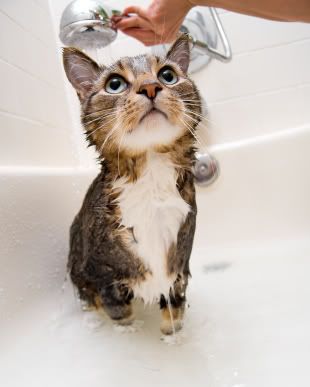 This last week I read a horrible posting from a person whose kittens had fleas.
This last week I read a horrible posting from a person whose kittens had fleas.
She would not take them to a veterinarian and wrote about how the kittens were dying after she applied flea treatment on to the kittens.
The kittens were convulsing and having trouble breathing as they died–it was both cruel and stupid.
In case you are not aware, it is not safe to apply flea treatments on young kittens.
On most flea control packages it states–“not for use on kittens under…” usually 8 to 12 weeks of age.
Nor is it a good idea to treat the mother without supervision of a veterinarian.
Some vets will ask their clients to take specific measures so that kittens do not suffer or die from flea bite anemia or other flea complications–but you should always check with your veterinarian before treating young animals (or their mothers) for fleas.
If you have a flea infestation on the queen or her kittens–CALL YOUR VETERINARIAN IMMEDIATELY for help.
Is it possible to treat fleas on a mother cat and her kittens?
Ideally, your queen will be flea free before she gives birth.
If you need to treat your cat and kittens you’ll need to use the Triangle of Successful Flea Control (outlined in Flea Control Secrets). After implementing the suggestions from the video, make sure you provide bedding that contains natural flea remedies INSIDE the bed.
Cedarwood is considered a low toxicity natural flea repellent for use in pet bedding.
Daily vacuuming and bed cover changing are two other necessary techniques.
Next, flea comb both the queen and the kittens.
If you have a heavy infestation you may be forced to use a non-toxic water dip or gentle shampoo solution.
Make sure to use warm water and use a room heater to increase the ambient temperature.
Warm some towels in the clothes dryer for use immediately after washing or water dipping the kitten.
If you prefer a water dip, just hold the kitten in the warm water for about five minutes and use a sprayer to help massage and dislodge the fleas.
Otherwise, many vets suggest bathing the kittens with a warm washcloth or in warm water using the gentle non-toxic baby or pet shampoo (avoiding the nose, ears and eyes) to create suds in the kitten’s fur. Leave the suds on for about five minutes before rinsing.
In their efforts to escape, fleas will crawl up to the head, nose, eyes and ears. You can use a small wash cloth to form a barrier around the neck or simply catch them with your fingers or tweezers.
Following these methods, wrap the kitten up in a warm towel and dry well. If you use a hair dryer make sure the setting is on low and blow from a distance so you don’t harm the feline.
Once the kitten’s fur is dry, again use the flea comb to remove any remaining fleas or flea dirt.
It might be a good idea to then place the kitten on a covered heating pad and let the mother or the kitten groom.
Be sure to also clean the mom–which may or may not be as easy.
It is often necessary to repeat this process a least once a week for the next couple of weeks.
Do you or your veterinarian have a method you recommend for kittens fleas? If so, leave a comment below.

